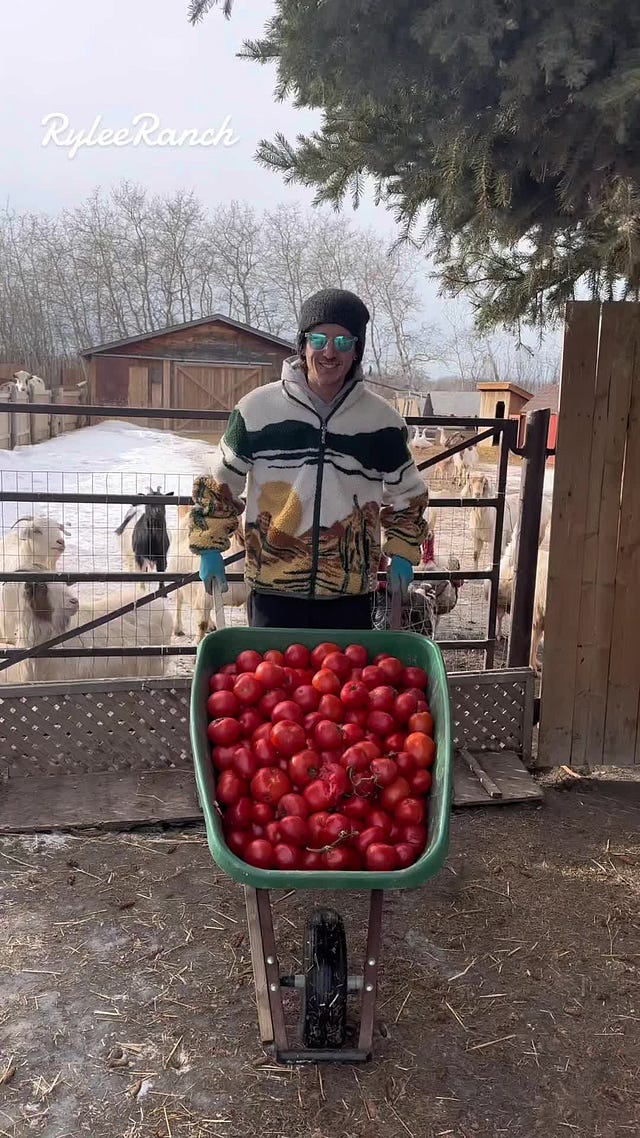Issue #85 | Risk Management Science vs Politics | Wasabi Fraud | Synbio and HFSS Foods Explained | Goats Eating Tomatoes |
2023-04-24
Risk management - science or politics?
Wasabi: green, pungent and usually fake
News and Resources Roundup
What on Earth is… (two new terms explained in 30 seconds)
Goats eating tomatoes - just for fun
Food fraud incidents, updates and emerging issues
Hey there!
Welcome to Issue 85 of The Rotten Apple and a big hello if you are new. It’s great to have you here.
Next month I am celebrating one year of paid subscriptions, which means that some of you will soon be receiving renewal reminders. I’d love to take this moment to thank my first wonderful paying subscribers for their support:
👏Victoria C, 👏Anne, 👏Rachel D, 👏Chris, 👏Pratik S, 👏Victoria, 👏Bruce P, 👏Meldy D, 👏Evan from SFTQld, 👏JoAnne E, 👏Stephanie, 👏Amber A, and 👏Richard from MQM.
👏 A special shoutout to Victoria from Switzerland, Leah W from Australia and Forward Food Solutions from WI for being 🍏Good Apple🍏 members - thank you! 👏
Risk management is political. So says Professor Don Schaffner, of Food Safety Talk Podcast fame. So not scientific then, eh? Read on to find out how human decision-making intersects with the science of risk assessment.
Wasabi paste is a magical part of raw fish sushi - at least for some of us. It also has significant anti-bacterial properties, which is kind of cool. But most of the wasabi paste we eat is completely ‘fake’. Or perhaps fake wasabi is so much the norm that we don’t care any more. What do you think, I’ve included a poll with this story so you can share your views with a single click.
Also this week, two new food terms explained in 30 seconds, because you’re busy and unexplained initialisms suck. Plus, as always, a round-up of food safety news (lots this week), and food fraud news for paying subscribers.
Have a great week,
Karen
P.S. If you haven’t made the leap to become a paying subscriber, it’s not too late to join us. Learn all about the benefits of a paid subscription by clicking the button below.
Risk Management - Science or Politics?
Risk analysis is a field of work that includes risk assessment, risk communication, and risk management. And risk management, it turns out, is more a question of politics than science.
Risk analysis = risk assessment + risk communication + risk management
Risk assessment is a scientific process that attempts to determine the size of a risk and the factors that impact it. Risk assessment is performed using data from scientific literature or other high-quality datasets.
Risk communication is exactly what you might imagine; talking to stakeholders about the risks discovered in a risk assessment.
Risk management is the process of taking the information from a risk assessment and using it to prioritise risk mitigation activities, in effect, deciding what to do about the risk.
Unlike risk assessment, risk management is not informed so much by science, as by politics. So said the esteemed food safety guru, Professor Don Schaffner, in a recent food safety webinar hosted by Virginia Tech.
Professor Don Schaffner suggests that most food safety professionals who work in industry - as opposed to academia - are “some sort of risk manager” and went on to describe risk management as a political process.
“Risk management is not a scientific process. It should hopefully be informed by science and informed by the scientific process, but I would characterize it as a political process. And we're [talking] political not as in political parties, but it's really a management process and it's not science. It really is dealing with tradeoffs that are not always able to be expressed quantitatively.
“A risk assessment will never tell, should never tell, a risk manager what to do. The risk assessment should lay out for the manager what the options are, and then it's up to the manager to make a decision about what to actually do about that risk.” Prof Schaffner
Yes, a risk assessment does not tell a risk manager what to do. It just categorises or ranks the risks so that decisions about how to deal with them can be made more effectively.
In food safety, risk management aims to reduce the risk posed by a food safety hazard - such as Salmonella, or glass fragment contamination - usually by taking action that will make the hazard less likely to occur.
For hazards like Salmonella or glass, it’s a no-brainer. In food manufacturing processes there are well-defined control systems for eliminating those hazards. For example, cooking processes can destroy Salmonella.
Risk management processes for hazards like Salmonella and glass rarely need to be debated. However, in the webinar I mentioned, Prof. Schaffner was talking about risk management in the context of agricultural water; specifically, food safety hazards that arise in fresh produce from agricultural water, like irrigation water and wash water.
How much Salmonella is okay in water used for irrigating a potato field? And how often should you test for it? Should levels be different for a field of lettuce since lettuce is eaten raw? Maybe, but how do you figure out the exact limits? These are the type of questions that keep food safety experts like Prof. Schaffner awake at night.
Risk assessment processes aim to quantify the risk posed by a hazard. Once the risk has been quantified, it is up to the risk manager to decide what to do about it. This means weighing up the costs, benefits and downsides of various mitigation actions.
The final course of action taken by a food or farming business will depend on the business’ appetite for risk, approach to compliance and willingness or ability to bear the financial cost of the mitigation activity. Often this will involve delicate discussions between people with different attitudes to risk and costs.
In other words, it’s political.
Watch a replay of the full webinar here.
Our April food safety news round-up includes an example of a quantitative risk assessment calculation done with norovirus exposure and consumption of oysters.
Wasabi: Frequently Faked, Always Antibacterial
Wasabi is one of those foods that is so frequently inauthentic that most consumers don’t really know what the ‘real thing’ tastes like. Another example would be powdered shelf stable ‘parmesan cheese’ which is not from Parma and not 100% cheese.
Wasabi is the pale-green paste served as an accompaniment to sushi. Wasabi is also the common name for the plant from which wasabi paste is (supposed to be) made, Wasabia japonica.
Wasabi paste has antibacterial properties due to the presence of the naturally occurring chemical allyl isothiocyanate in the wasabi plant. For example, a broth of 4% commercially available wasabi powder can inhibit the growth of cultures of Escherichia coli and Staphylococcus aureus (source).
Genuine wasabi paste is made by finely grating the rhizome (root) of the wasabi plant until it has a paste-like consistency. Wasabi plants, however, are difficult to cultivate, making the roots costly to purchase. Once ground into a paste, it loses its pungency quickly, making it virtually impossible to produce high-quality packaged wasabi paste.
Most packaged wasabi paste is made with horseradish, which is white in colour and has a hotter, more pungent ‘burn’ than genuine wasabi. It also contains green food colouring, to mimic genuine wasabi.
The horseradish used in ‘fake’ wasabi also contains allyl isothiocyanate, so non-genuine wasabi also has anti-bacterial properties. In fact, it’s the isothiocyanate compounds in both horseradish and wasabi that give them their pungency (source).
Here’s a video showing how genuine wasabi paste is made.
 Tiktok failed to load.
Tiktok failed to load.Enable 3rd party cookies or use another browser
Food fraud or not?
So if all pre-packaged ‘wasabi’ is made with horseradish and contains only small amounts of Wasabia japonica root, or none at all, does that mean it is ‘fake’? And is that ‘food fraud’?
What do you think?
For me, the answer is no. The word ‘wasabi’ has come to mean a pale-green condiment, not a freshly-grated rhizome (no source for this, just opinion😁). Food fraud must involve deception and I don’t think consumers are being deceived in a significant way in this context.
Food Saftey News and Resources
Heaps of interesting news this week, including worrying new numbers around the safety of BPA, deadly outbreaks, unusual recalls and a bunch of helpful free training webinars. Click the preview box below to access it.
What on Earth is… (Two New Food Terms Explained)
Synbio
Synbio is short for ‘synthetic biology’. The term has been used since the early 2000s in molecular biology circles, but it has only recently started popping up in food science spaces.
“Synthetic biology is a field of science that involves redesigning organisms for useful purposes by engineering them to have new abilities.” The National Human Genome Research Institute
In food, synbio refers to the production of foods and food components using molecular biology and genome-editing techniques. You’ll see it applied to cultured meat and plant-based burgers that contain synthesised heme proteins to simulate animal blood, for example.
HFSS
This initialism seems to be all over the international food industry media lately, usually without an explanation of what it stands for.
It stands for ‘high in fat, salt and sugar’.
There is an official definition for HFSS foods in the United Kingdom (UK), where the term was created as part of that country’s Childhood Obesity Plan. HFSS foods are not allowed to be promoted in certain parts of retail environments, including online retail, under new UK laws that came into effect in 2022 (source).
Goats Eating Tomatoes - Just for Fun
Forty-seven seconds of goats eating tomatoes. 100% safe for work. Smiles guaranteed.

 Tiktok failed to load.
Tiktok failed to load.Enable 3rd party cookies or use another browser
What you missed in last week’s email
· Maple syrup: adulteration, fluorescence, hoarding and fraud detection tech
· VACCP in 2023, live training replay
· Bears for dinner - just for fun (but it’s not really fun)
· Food fraud incidents, updates and emerging issues
Below for paying subscribers: Food fraud news, incident reports, and emerging issues, plus an 🎧 audio version of this email 🎧 so you can catch up while on the go
📌 Food Fraud News 📌
Manuka honey fraud and backlash
A survey of 46 brands of manuka honey in US and UK markets found that 100% failed to meet




